
An unofficial animated guide to
Dr. Jordan B. Peterson's book Maps of Meaning

JBP's original text with interactive colour markers. Recommended for those reading Maps of Meaning.
Simpler step-by-step explanations written by yours truly. Recommended for beginners.


The world can be validly construed as a forum for action, as well as a place of things. We describe the world as a place of things, using the formal methods of science. The techniques of narrative, however – myth, literature, and drama – portray the world as a forum for action. The two forms of representation have been unnecessarily set at odds, because we have not yet formed a clear picture of their respective domains. The domain of the former is the “objective world” – what is, from the perspective of intersubjective perception. The domain of the latter is “the world of value” – what is and what should be, from the perspective of emotion and action.
p. xxi.
The world as forum for action is “composed,” essentially, of three constituent elements, which tend to manifest themselves in typical patterns of metaphoric representation. First is unexplored territory– the Great Mother, nature, creative and destructive, source and final resting place of all determinate things. Second is explored territory– the Great Father, culture, protective and tyrannical, cumulative ancestral wisdom. Third is the process that mediates between unexplored and explored territory – the Divine Son, the archetypal individual, creativeexploratory“Word” and vengeful adversary. We are adapted to this world of divine characters, much as to the objective world. The fact of this adaptation implies that the environment is in “reality” a forum for action, as well as a place of things.
p. xxi.
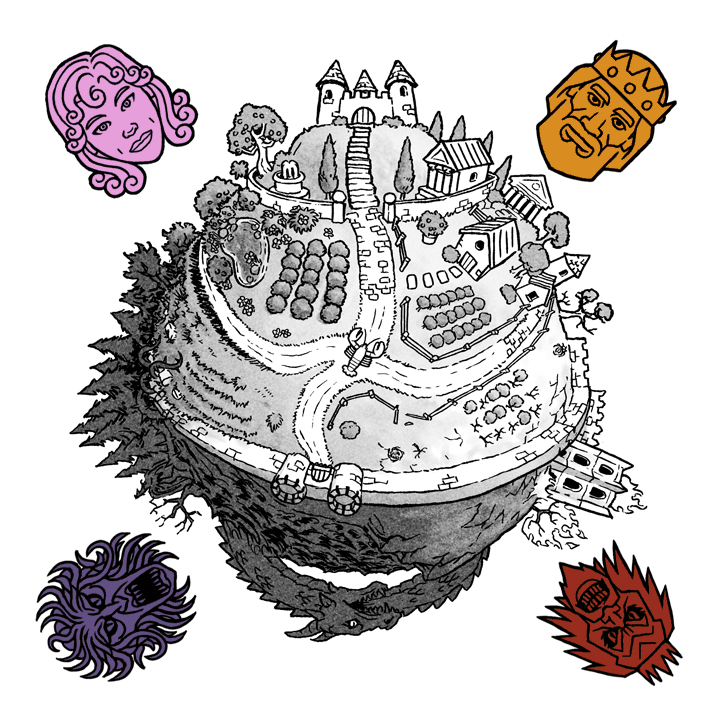

No complete world-picture can be generated, without use of both modes of construal. The fact that one mode is generally set at odds with the other means only that the nature of their respective domains remains insufficiently discriminated. Adherents of the mythological world-view tend to regard the statements of their creeds as indistinguishable from empirical “fact,” even though such statements were generally formulated long before the notion of objective reality emerged. Those who, by contrast, accept the scientific perspective – who assume that it is, or might become, complete – forget that an impassable gulf currently divides what is from what should be.
We need to know four things:
• what there is,
• what to do about what there is,
• that there is a difference between knowing what there is, and knowing what to do about what there is
• and what that difference is.
pp. 1-2.
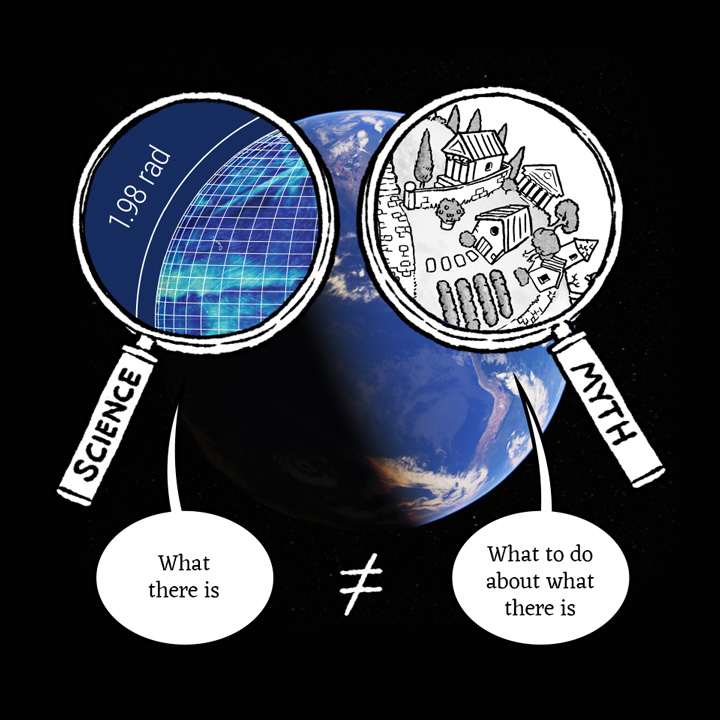

We may construct models of “objective reality,” and it is no doubt useful to do so. We must model meanings, however, in order to survive. Our most fundamental maps of experience – maps which have a narrative structure – portray the motivational value of our current state, conceived of in contrast to a hypothetical ideal, accompanied by plans of action, which are our pragmatic notions about how to get what we want.
Description of these three elements – current state, future state, and means of mediation – constitute the necessary and sufficient preconditions for the weaving of the most simple narrative, which is a means for describing the valence of a given environment, in reference to a temporally and spatially bounded set of action patterns.
pp. 22-23.
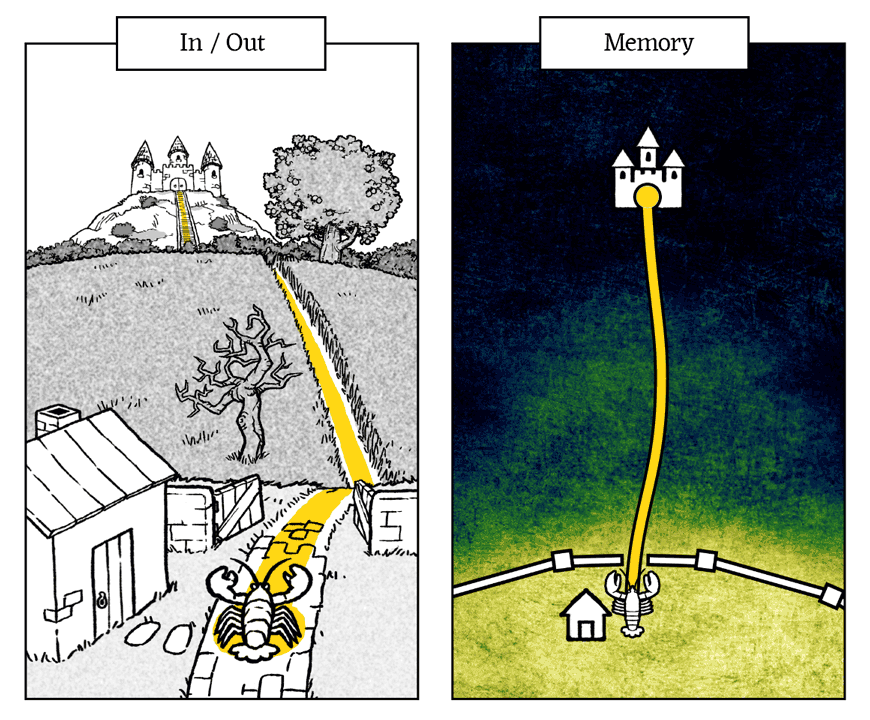
Getting to point “b” presupposes that you are at point “a” – you can’t plan movement in the absence of an initial position. The fact that point “b” constitutes the end-goal means that it is valenced more highly than point “a” – that it is a place more desirable, when considered against the necessary contrast of the current position. It is the perceived improvement of point “b” that makes the whole map meaningful – that is, affect-laden; it is the capacity to construct hypothetical or abstract end points, such as “b” – and to contrast them against “the present” – that makes human beings capable of using their cognitive systems to modulate their affective reactions. The “domain” mapped by a functional narrative (one that, when enacted, produces the results desired) might reasonably be regarded as “explored territory,” as events that occur “there” are predictable.
pp. 22-23.
Any place where enacted plans produce unexpected, threatening or punishing consequences by contrast, might be regarded as “unexplored territory.” What happens “there” does not conform to our wishes. This means that a familiar place, where unpredictable things start happening, is no longer familiar (even though it might be the same place with regards to its strict spatial location, from the “objective” perspective).
p.23
We know how to act in some places, and not in others. The plans we put into action sometimes work, and sometimes do not work. The experiential domains we inhabit – our “environment,” so to speak – are therefore permanently characterized by the fact of the predictable and controllable, in paradoxical juxtaposition with the unpredictable and uncontrollable. The universe is composed of “order” and “chaos” – at least from the metaphorical perspective. Oddly enough, however, it is to this “metaphorical” universe that our nervous system appears to have adapted.
p.23
The process of creative exploration – the function of the knower, so to speak, who generates explored territory – has as its apparent purpose increase in the breadth of motoric repertoire (skill) and alteration of representational schema. Each of these two purposes appears served by the construction of a specific form of knowledge, and its subsequent storage in permanent memory. The first form has been described as knowing how. The motor unit, charged with origination of newbehavioral strategies when old strategies fail (when they produce undesired results), produces alternate action patterns, experimentally applied, to bring about the desired result. Permanent instantiation of the new behavior, undertaken if the behavior is successful, might be considered development of new skill. Knowing how is skill.
p.72
The second type of knowing, which is representational (which is an image or model of something, rather than the thing itself) has been described as knowing that – I prefer knowing what. Exploration of a novel circumstance, event, or thing, produces new sensory and affective input, during active or abstracted interaction of the exploring subject and the object in question. This new sensory input constitutes grounds for the construction, elaboration and update of a permanent but modifiable four-dimensional (spatial and temporal) representational model of the experiential field, in its present and potential future manifestations.
p.72

(Nothing in this section yet)

(Nothing in this section yet)

Following in the footsteps of others seems safe, and requires no thought – but it is useless to follow a well-trodden trail when the terrain itself has changed. The individual who fails to modify his habits and presumptions as a consequence of change is deluding himself – is denying the world – is trying to replace reality itself with his own feeble wish. By pretending things are other than they are, he undermines his own stability, destabilizes his future – transforms the past from shelter to prison.
p. 327.
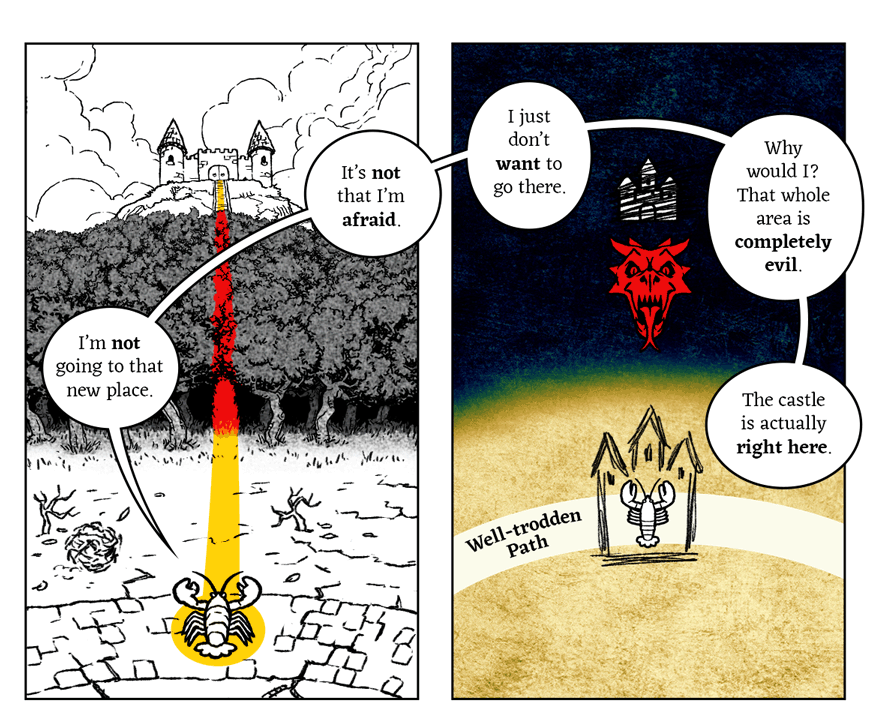
The lie is willful adherence to a previously functional schema of action and interpretation – a moral paradigm – in spite of new experience, which cannot be comprehended in terms of that schema; in spite of new desire, which cannot find fulfillment within that previous framework. The lie is willful rejection of information apprehended as anomalous on terms defined and valued by the individual doing the rejection. That is to say: the liar chooses his own game, sets his own rules, and then cheats. This cheating is failure to grow, to mature; is rejection of the process of consciousness itself.
The lie is therefore not so much a sin of commission, in most cases, as a sin of omission (although it may take the former condition as well). The lie is a matter of voluntary failure to explore, and to update.
pp. 327-328.
The lie is easy, and rewarding, as it allows for the avoidance of anxiety – at least in the short term. In the long run, however, the lie has terrible consequences. The “avoidance or suppression” of novel orunexpected experience, which is the abstract equivalent of running away, transforms it perforce into determinate threat (is the categorical equivalent of labelling as threat). The domain of unprocessed novelty, defined prima facie by inaction and avoidance as “threat too intolerable to face,” expands inevitably with time, when the past is held as absolute. More and more experience is therefore rendered intolerable, inexplicable, and chaotic, as the cumulative effects of using the lie as a mode of adaptation inexorably manifest themselves.
p. 329.
The lie transforms culture into tyranny, change into danger, while sickening and restricting the development and flexibility of adaptive ability itself. Reliance on the lie ensures – as fears grows – heightened, pathologized identification with the past (manifested as fascism, as personal and political intolerance), or decadent degeneration (manifested as nihilism, as personal and social deterioration).
p. 333.
The heroic attitude is predicated on the belief that something newand valuable still exists, to be encountered and assimilated, regardless of the power and stability of the current position. This belief is further based upon faith in human potential – upon faith that the individual spirit will respond to challenge, and flourish. Such belief must be posited – voluntarily, freely – prior to participation in any heroic endeavor. This is the necessary leap that makes courageous and creative action possible; that makes religion something real. Humility means, therefore: I am not yet what I could be – an adage both cautious and hopeful.
p. 333.
The personality of the adversary comes in two forms, so to speak – although these two forms are inseparably linked. The fascist sacrifices his soul, which would enable him to confront change on his own, to the group, which promises to protect him from everything unknown. The decadent, by contrast, refuses to join the social world, and clings rigidly to his own ideas – merely because he is too undisciplined to serve as an apprentice.
p. 307.
The fascist and the decadent regard each other as opposites, as mortal enemies. They are in actuality two sides of a bent coin.
p. 335.
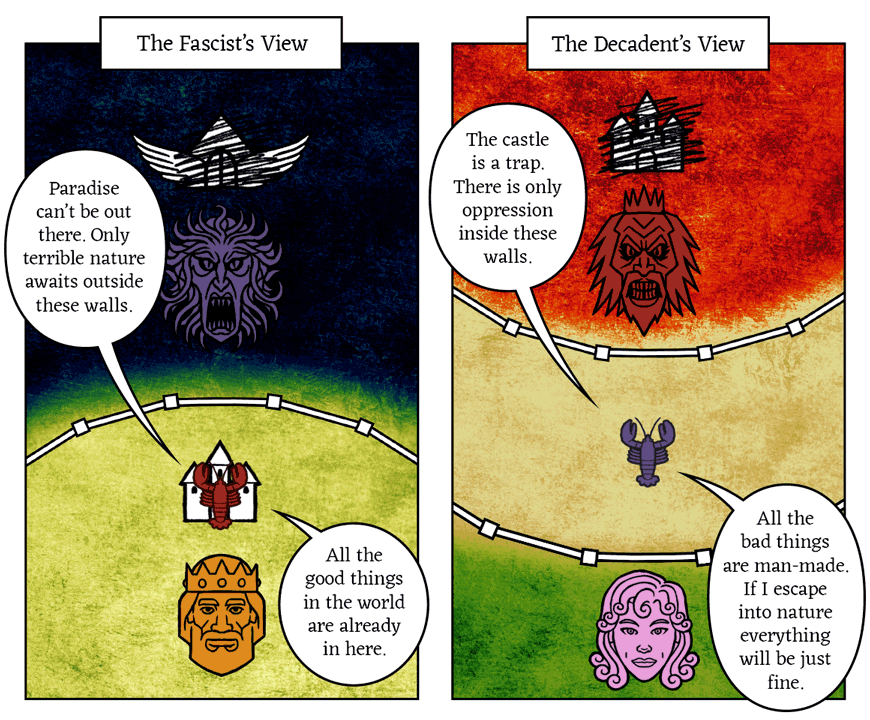
The adversarial position, deceit, is predicated on the belief that the knowledge ofthe present is all necessary knowledge – is predicated on the belief that the unknown has finally been conquered. This belief is equivalent to denial of vulnerability, equivalent to the adoption of omniscience – “what I do is all there is to do, what I know is all there is to know.” Inextricably associated with the adoption of such a stance is denial, implicit or explicit, of the existence, the possibility, and the necessity of the heroic – as everything worthwhile has already been done, as all problems have been solved by the “ancestral heroes,” who predeceased us, as paradise has already been spread before us.
p. 333.
The fascist adapts to the group with a vengeance. He builds stronger and stronger walls around himself, and those who are “like him,” in an ever-more futile attempt to keep the ever-more-threatening unknown at bay. He does this because his world-view is incomplete. He does not believe in the heroic aspect of the individual, he does not see the negative aspect of the social world, and he cannot visualize the beneficial aspect of chaos. He is frightened enough to develop the discipline of a slave, so that he can maintain his protected position in the group, but he is not frightened enough to transcend his slavish condition. He therefore remains twisted and bent.
pp. 334-335.
The decadent, by contrast, sees nothing but the tyrannyof the state. Since the adversarialaspect of the individual remains conveniently hidden from his view, he cannot perceive that his “rebellion” is nothing but avoidance of discipline. He views chaos as a beneficial home, seeing the source of human evil in social regulation, because he cannot imagine the Terrible Mother, as soul-devouring force. So he abandons his father in the belly of the beast, unredeemed – and has no tools to rely on when he finally faces a true challenge.
p. 335.
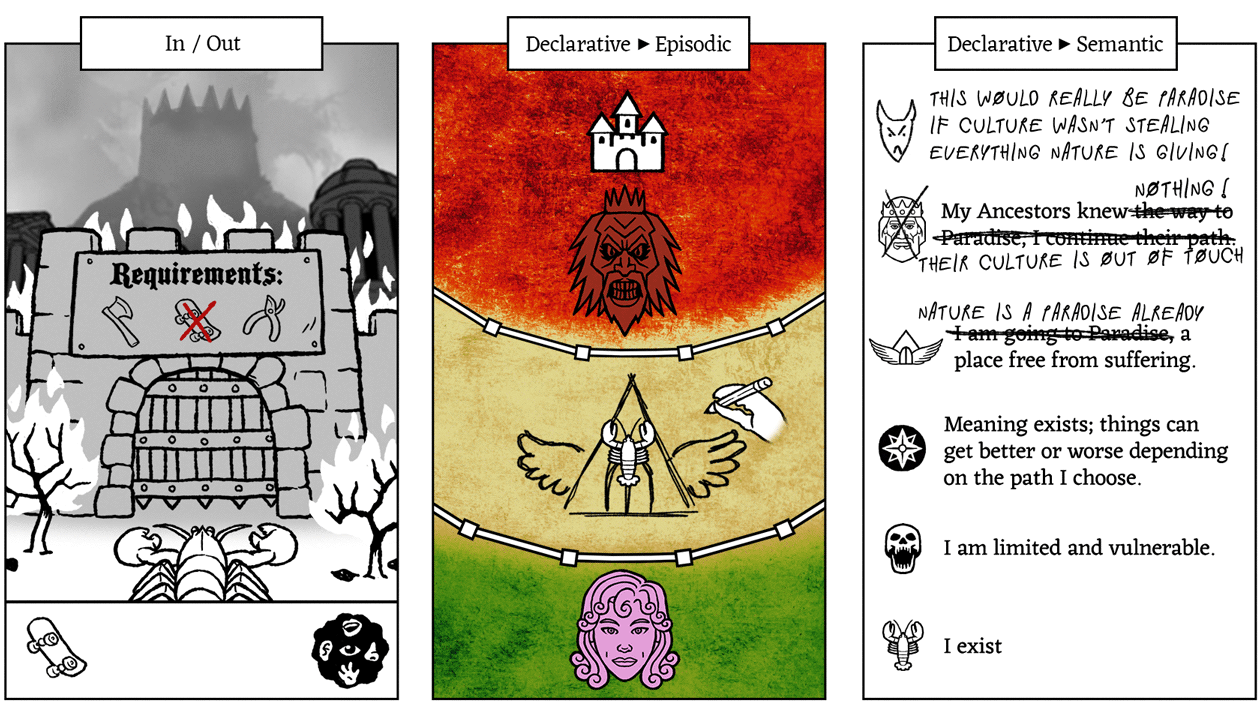
The decadent looks to subvert the process of maturation – looks for a “way out” of group affiliation. Group membership requires adoption of at-least-adolescent responsibility – at least of the responsibilities associated with respectable behavior – and this burden may seem too much to bear, as a consequence of prolonged immaturity of outlook. The decadent therefore acts “as if” the paradigmaticstructure ofthe group has beenrendered“insufficient” – as a consequence of environmental, cultural or intellectual change – and refuses to be the fool who risks belief. The “proper” response to “the illness of the father,” is, of course, “the journeyto the land ofliving water.” The decadent makes his intellectual superiority to the “superstitious of the past” an article of faith, instead, and shirks his responsibility. [That is to say – it is the desire to shirk that responsibility (and the “heroic sacrifice” it entails), that constitutes motivation for belief in “intellectual superiority.”] The “suffering rebel” stance that such adoption allows, as a secondary consequence, also serves admirably as mask for cowardice.
p. 335.
The decadent believes that freedom can be attained without discipline and responsibility, because he is ignorant of the terrible nature of “the undifferentiated ground of reality,” and is unwilling to bear the burden of order. When he starts to suffer– as he certainly will – he will not allow the reality of his suffering to prove to him that some things are real, because acceptance of that proof would force him to believe and to act (would force him as well towards painful realization of the counterproductive and wasteful stupidity of his previous position).
p. 339.
But he is living on borrowed time – feeding, like a parasite, on the uncomprehendedbody of the past. If he works sufficiently hard, and saws off the branch on which he is sitting, then he will fall, too, into the jaws of the thing he ignored.
p. 341.